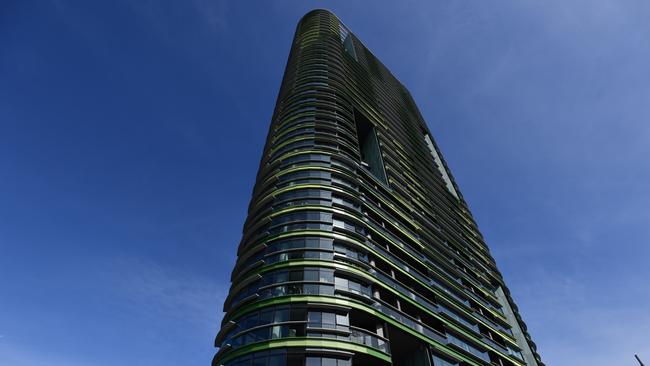Blame game ignites over Sydney’s Opal Tower
A public blame game has erupted between the developer and the builder of the cracked western Sydney high-rise Opal Tower.

A fierce and public blame game has erupted between the developer and the builder of the cracked western Sydney high-rise Opal Tower, with the parties positioning for an expected legal maelstrom over who will bear liability for the damage and economic loss to unit owners.
The developer, Ecove, took the extraordinary step yesterday of revealing aspects of a confidential contract with the builder, Icon, in a bid to establish that Icon was responsible for both the construction and detailed design of the 36-storey apartment building at Olympic Park in Homebush. Icon retaliated, a spokeswoman telling The Australian “our priorities remain the safety and welfare of the residents and rectifying the issue, not on attempting to cover our backsides”.
Uncertainty surrounds just when the residents of the building, about 300 in total, will be allowed to start moving back into the 392-unit complex.
Icon was unable to provide any clear timeline despite the design and construction engineers it had engaged on the project, WSP, saying on Monday that Opal Tower was “structurally sound overall” and most of it could be progressively reoccupied.
The Icon spokeswoman said “investigations continue, rectification works begin”. “Reoccupation will only occur after authorities can agree safety processes to ensure that residents are separated from potentially harmful equipment, and any required approvals are granted.”
Opal Tower was approved as a state significant development by Department of Planning officials rather than the local council, whose powers over the whole Olympic Park area were removed before the 2000 Games when it was declared a state significant site.
Keenly aware that the state government could be seen to shoulder some responsibility, Planning Minister Anthony Roberts quickly launched an initial investigation into compliance with building approvals and as the outcry grew intervened further by appointing two university deans of engineering to conduct an independent investigation of the building.
While the state significant development declaration is often regarded as a fast-track around local councils, a Department of Planning spokesman said projects on state significant sites were assessed by “with the same rigour and quality as would be the case if undertaken by a council.”
Opal Tower, which started taking occupants in August, was evacuated on Christmas Eve when cracks opened up in a concrete panel on the 10th floor, accompanied by banging noises in the building. While most residents were soon allowed to return, late last week Icon moved all inhabitants to nearby hotels and other accommodation, so as to investigate the whole building and start remedial work.
In a statement on Monday, WSP said its engineers had found two more sets of cracks, on the fourth floor, and had installed more steel support struts as a precautionary measure.
A source close to one of the many parties involved yesterday told The Australian: “I’m certain we’re at the beginning of what will inevitably be a lengthy legal process.”
In its statement yesterday, Ecove sought to distinguish itself as the developer of Opal Tower, from Icon as builder, in terms of who bore responsibility for design and construction.
“This project is being delivered via a ‘design and construct’ contract,” Ecove said in the statement. “Under this the developer presents the builder with an initial design concept. The builder then develops the detailed design, in accordance with all the building codes and authority requirements but staying within the concept.”
There had been some speculation that since much of the site developed for the 2000 Olympic Games had been reclaimed from swampy land, it was inherently unstable for high-rise development.
But in the statement, Ecove said “we are confident there is no issue with the foundations as they are built on shale bedrock, which is common in Sydney”.
With engineers also ruling out an inherent fault in the prefabricated concrete panels that cracked in the architectural “slots” for gardens, the problem is now thought to relate either to errors in construction, or the design of the building.
The building was designed by architectural firm Bates Smart, which on its website highlighted “a series of dramatic vertical communal sky gardens providing environmental benefits”.




